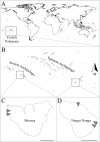Consistency in the supply of larval fishes among coral reefs in French Polynesia
- PMID: 28594864
- PMCID: PMC5464576
- DOI: 10.1371/journal.pone.0178795
Consistency in the supply of larval fishes among coral reefs in French Polynesia
Abstract
For marine fishes with a bipartite life cycle, pelagic larval dispersal can shape the distribution, connectivity, composition and resilience of adult populations. Numerous studies of larval dispersal, and associated settlement and recruitment processes, have examined the relationship between population connectivity and oceanographic features. However, relatively little is known about spatial and temporal variation in the abundance of larvae settling among different reefs and the extent to which the species assemblage of larvae settling at one location is reflective of the assemblage in neighbouring areas. Here, using crest nets, which provide a non-selective measure of the total abundance and assemblage of larvae settling to a reef (i.e. larval supply), we collected larval coral reef fishes at five locations surrounding two spatially disparate French Polynesian islands: Moorea and Nengo-Nengo. Overall, larval settlement patterns were correlated with the lunar cycle, with larval abundance peaking during the new moon. Although there were some spatial differences in larval supply among the five monitored sites, settlement patterns were largely consistent, even at the species level, irrespective of factors such as coastline orientation or distance between sites. This study provides further insights into the mechanisms driving patterns of dispersal and settlement of larval fishes over large spatial scales.
Conflict of interest statement
Figures


References
-
- Begon M, Townsend CR, Harper JL. Ecology–From Individuals to Ecosystems. Blackwell Publishing; 2005.
-
- Hjort J. Fluctuations in the great fisheries of Northern Europe. Cons Perm Int pour l’Exploration la Mer. 1914;XX: 237 pp.
-
- Clobert J, Baguette M, Benton TG, Bullock JM. Dispersal ecology and evolution Oxford University Press; 2012.
-
- Green AL, Maypa AP, Almany GR, Rhodes KL, Weeks R, Abesamis RA, et al. Larval dispersal and movement patterns of coral reef fishes, and implications for marine reserve network design. Biol Rev. 2015;90: 1215–1247. doi: 10.1111/brv.12155 - DOI - PubMed
-
- Cowen RK, Sponaugle S. Larval Dispersal and Marine Population Connectivity. Annu Rev Mar Sci. 2009;1: 443–66. - PubMed
MeSH terms
LinkOut - more resources
Full Text Sources
Other Literature Sources

